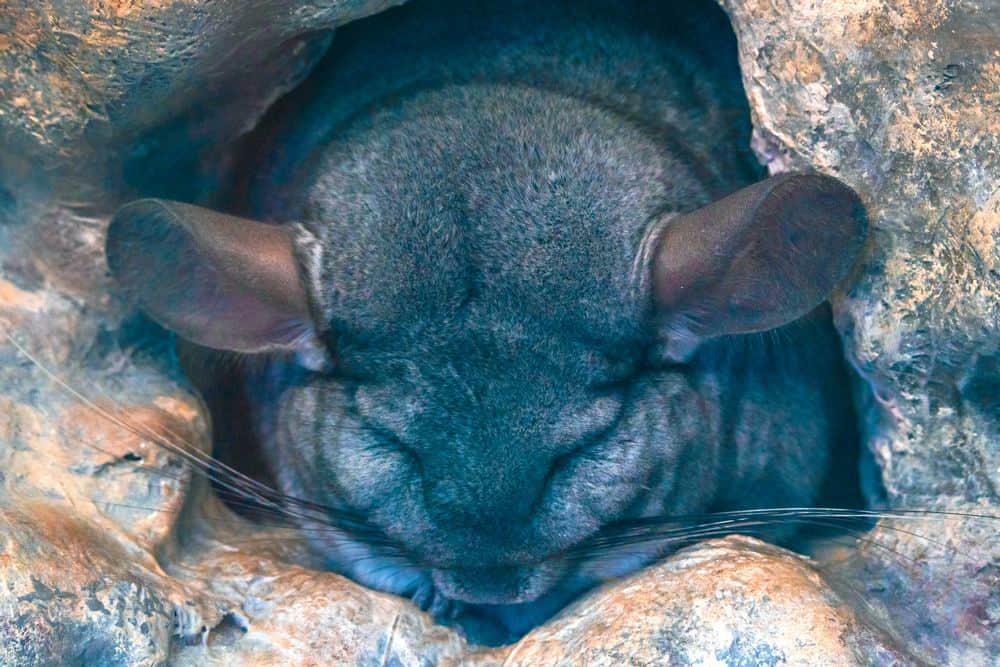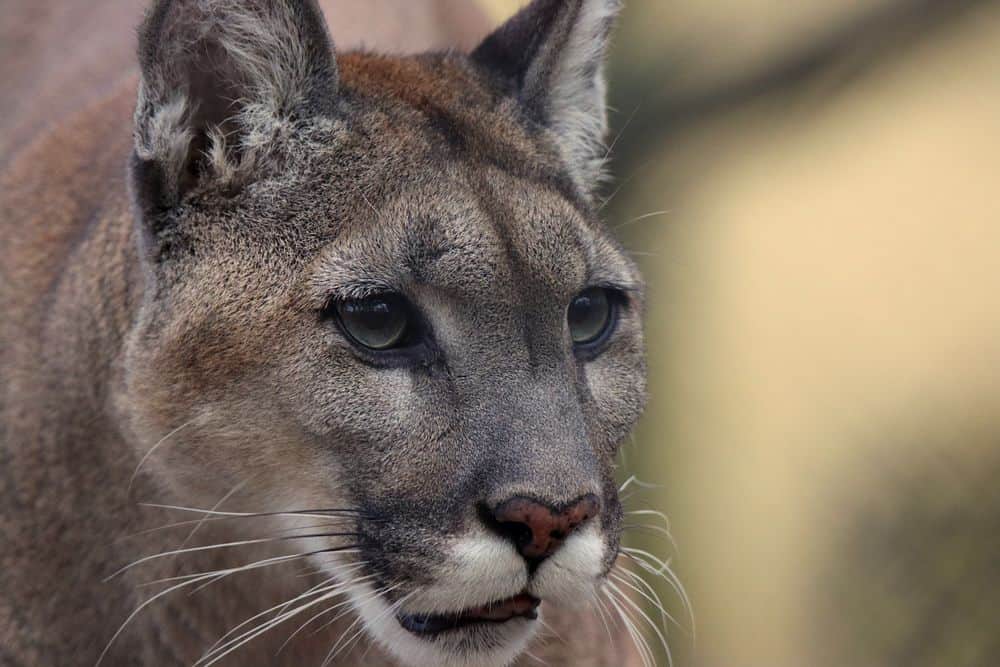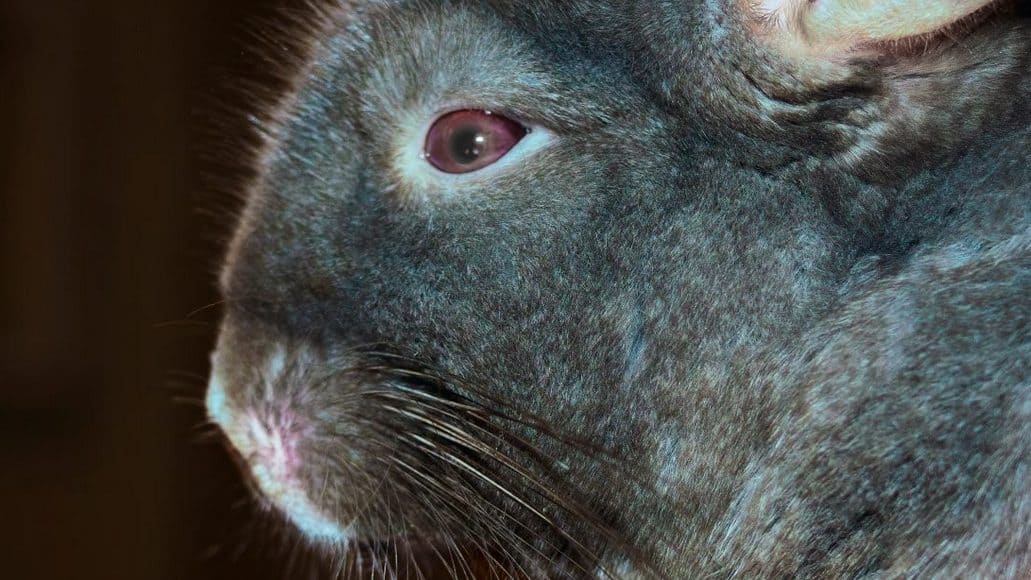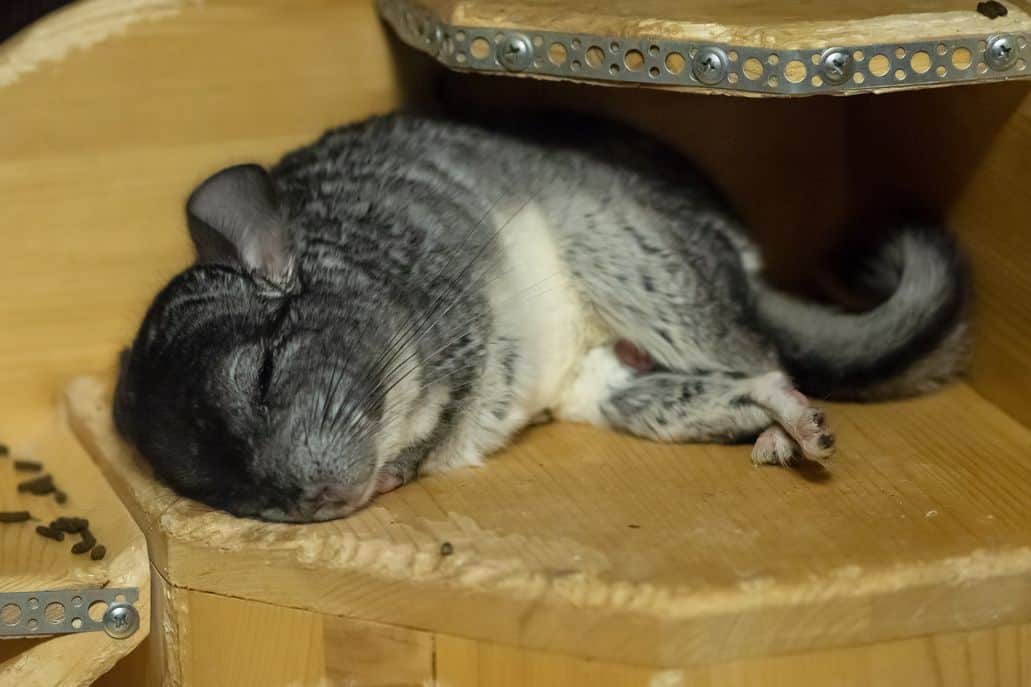
And having to live in the wild, surrounded by hungry animals far larger than you.
You would need to come up with some good ways to defend yourself from threats.
And that’s exactly what the chinchilla has done.
There is one especially cool chinchilla defense mechanism, but it is far from the only one.
Chinchillas have many ways to protect themselves from danger. Keep reading for a complete list of all the defense mechanisms chinchillas use to keep themselves safe and alive in a dangerous world.
Contents
How Do Chinchillas Defend Themselves?
Chinchillas are small rodents and prey animals. When threatened, they prefer hiding or running away, instead of attacking. But they do have some tricks up their sleeves.
They will sometimes use a defense mechanism called “fur slip”, wherein they release a large chunk of fur to startle their predators.
Other ways in which chinchillas defend themselves include standing on their hind legs, fluffing their coats and tails, biting, and maintaining a stiff posture. Let’s take a look at the main defense mechanisms chinchillas use to protect themselves from predators.
How Do Chinchillas Escape From Predators?

There are several ways in which chinchillas escape from their predators. Good thing, too, since they have a lot of predators (we’ll go over the main ones below).
Living In Colonies
In the wild, chinchillas live in large colonies of about 100. By living in such large numbers, they can take advantage of strength in numbers to more easily defend themselves from wild animals.
Chinchillas even coordinate among themselves when there is a predator nearby. They may use high-pitched squealing sounds to alert each other about the danger. Elder chinchillas also protect the younger ones by guiding them to safety.
Fur Slip
Chinchillas use a defense mechanism known as fur slip when they are threatened. When they are caught by a predator, they release a large chunk of their fur. This action startles the predator. It has no choice but to release its hold on the chinchilla, which then escapes.
Burrowing
Wild chinchillas are native to the Andes. They live at altitudes of 9,000 to 16,000 feet. They are excellent burrowers and hide in cracks and crevices between rocks.
They usually burrow at the base of rocks to hide from predators like birds. These burrows offer a haven to the chins, and most predators are unable to crawl their way into these tight, narrow spaces. Chinchillas may also use the existing empty burrows of other animals to hide from their enemies.
Using Speed And Agility
Being small animals, chinchillas are quite agile and fast. They can swiftly navigate through tight crevices and gaps between rocks to evade predators. They run as swiftly as their short but strong legs allow them. Using speed and agility, they easily outrun larger predators.
Climbing
Chinchillas can also climb quickly to get away from their predators. If a tree is available, this small rodent will climb on it to escape ground predators. Chinchillas will even hide in the branches if predators are nearby.
Hiding

Chinchillas usually avoid confrontation and prefer hiding when faced with a threat. They are prey animals and are naturally docile and submissive.
Also, they are blessed with a color that closely matches the color of the rocks and shrubs found in their natural habitats. They use this to their advantage to camouflage and hide from predators.
Standing On Their Hind Legs
Chinchillas also stand on their hind legs to appear larger and more intimidating to the threatening predator. They appear larger by fluffing up their fur and tails to establish their dominance.
Biting
As a last resort, chinchillas may bite their attackers to defend themselves. Chinchilla bites are quite painful, since they have incredibly sharp teeth that can pierce through the skin, causing deep wounds.
What Chinchillas Do When They Feel Threatened
When a chinchilla feels threatened, it might show the following signs. If you see your pet chinchilla doing any of these, try to figure out what is causing it to feel threatened and remove the threat, if possible.
Freezing On The Spot
A threatened chinchilla may freeze on the spot or stop moving completely. It may appear tense or rigid.

Raising Fur
Some chins also fluff up their tails and raise their fur – a phenomenon known as piloerection – to appear larger and more intimidating to the source of the threat. This is a common response in small animals and rodents like chinchillas.
Hiding Or Attempting To Escape
Most chinchillas will respond to a threat by attempting to escape or hide. In the wild, a chinchilla might escape into its burrow. In captivity, it might retreat inside a tunnel or a hideout provided in the cage. Make sure you give your pet a good nest box or hideout.
Squealing And Vocalizing
A threatened chinchilla is highly likely to vocalize. This may be in the form of high-pitched squeals, chirps, or other sounds and noises that show its distress.
Becoming Aggressive
In rare cases, a chinchilla may use aggression to counter a threat. Signs of aggression in chinchillas include biting, lunging, attacking, or hissing.
As stated before, chins rarely use aggression. They are prey animals and prefer hiding or running away when threatened. But it is important to remember that every chinchilla is different and has a different personality.
Increased Heart-rate And Signs Of Anxiety And Agitation
Chinchillas are sensitive animals, and when they feel threatened, they can get stressed and anxious. They may have an increased heart rate and show signs of agitation. Over time, this stress can manifest in the form of a dull coat, hair loss, a lack of appetite, and even weight loss.
Common Chinchilla Predators

Due to their small size, it comes as no surprise that chinchillas are a favorite meal for many larger animals. They following animals have all been known to prey on the chinchilla.
Birds
Birds like falcons, owls, hawks, and eagles are known to eat chinchillas. These predators can easily swoop down on an unsuspecting chinchilla and carry it to their nests.
Thankfully, by living in large herds and staying inside burrows, chinchillas can protect themselves from these aerial predators.
Mammals
Animals like skunks, foxes, and cougars are also known to prey on chinchillas. However, chinchillas easily use defense tactics like the fur slip, as well as agility and speed, to escape these animals. They also hide inside tight spaces and cracks to prevent getting caught in the first place
Reptiles
Snakes can easily sneak up on unsuspecting chinchillas and eat them. Unfortunately, many chinchillas fall prey to snakes when they are searching for burrows or crevices in rocks in which to hide.
Humans
Perhaps the biggest predator of chinchillas are us humans. Chinchilla meat is considered a delicacy in some parts of the world, and hunters make good money by selling these animals.
Moreover, chinchilla fur is also used in making purses, coats, gloves, and other items. The need of insecure celebrities like Floyd Mayweather to prove their worth by displaying their wealth has considerably reduced the chinchilla population.
What Do Chinchillas Do When They Fight?

Chinchillas rarely fight, but they will do so when they feel threatened or if their territory is invaded. Here are some things you can expect when a chinchilla goes to war.
Aggression
Some chinchillas use physical aggression while fighting. They may bite, attack, lunge, snark, growl, and hiss. They use these actions to show their physical dominance.
Vocalization
Chinchillas often use high-pitched squeaking, chirping, hissing, or growling when they fight. This may indicate pain and distress, as well as a warning to the other chinchilla to stay away.
Piloerection
During a fight, chins tend to stand on their hind legs to appear more menacing or threatening. In addition, they may fluff their fur and tails to appear larger.
Submission
A submissive chinchilla, or the one who loses the fight, will tuck its tail and usually retreat or hide to prevent further escalation.
Do Chinchillas Show Pain?

Yes, chinchillas show pain. Here are some of the common indications that a chinchilla is in pain.
- Behavioral changes: Your chinchilla might show aggression, fear, decreased activity, restlessness, hiding, etc. if it is in pain.
- Changes in appearance: Chins are fastidious groomers and love to take care of their appearance. But if a chinchilla gets sick or injured and is in great pain, it will not groom itself. As a result, its coat may turn matted and dirty.
- Appetite changes: A chinchilla in pain might refuse to eat, including its favorite treats. It might also lose weight or get sick due to nutritional deficiencies caused by the lack of eating.
- Abnormal posture: It might show an abnormal posture where its tail may be tucked in between its legs or it is hunched over. If the pain is in one leg or foot, your pet might avoid putting weight on that foot.
- Vocalizing: Some chinchillas tend to use vocalization to indicate pain. This may be in the form or chirps, squeals, whining, etc.
How Do Chinchillas Defend Themselves: Final Thoughts
The fur slip is definitely the most unusual chinchilla defense mechanism, but it is far from the only one. And it is not the most useful. The most useful behavior is to hide or run away and stay clear of predators altogether.
But if a predator does manage to get hold of a poor little chinchilla, the fur slip works well as a last resort. It can save the chinchilla’s life and it is more effective than trying to fight, which does not work well against much larger predators.
Leave a Reply